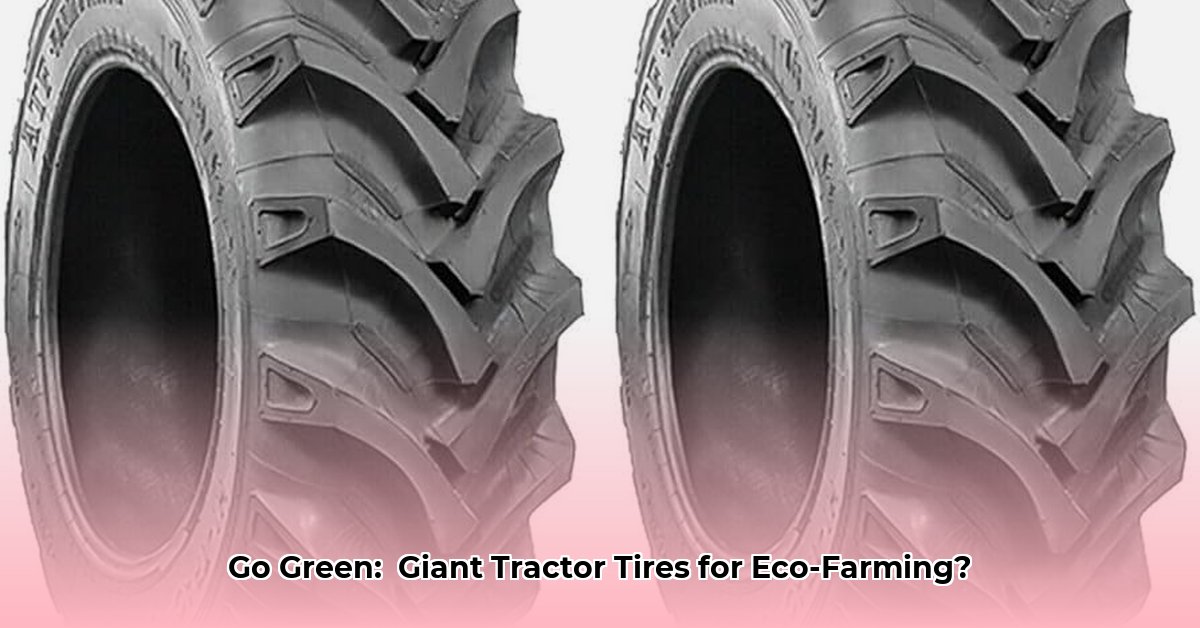
13.6 x 28 Tractor Tires and Their Environmental Impact
Let's talk about those ubiquitous 13.6 x 28 tractor tires – essential for modern farming, yet possessing a surprisingly large environmental footprint. This isn't just about fuel consumption; the tires themselves, from manufacture to disposal, significantly impact our planet. This article explores minimizing that impact through sustainable practices and responsible choices, benefiting both your farm's bottom line and the environment. For more on large agricultural machinery, see this resource.
Minimizing Soil Compaction: The Gentle Giant Approach
Large machinery and large tires often lead to soil compaction. Under-inflation exacerbates this, increasing wear, soil damage, and hindering water absorption and plant growth. Over-inflation, conversely, harms the tires and reduces traction. Finding the ideal tire pressure for your soil type is crucial. Think of it as the Goldilocks principle – you need the "just right" pressure. But proper inflation isn't the only factor.
Precision farming technologies, like GPS guidance systems, optimize routes, reducing passes across fields, and thus minimizing soil compaction. Fewer passes mean less soil disturbance and potential fuel savings. These technologies enhance the efficiency of existing equipment, reducing the need for larger, even more impactful machinery. Isn't this a win-win, both environmentally and economically?
Fuel Efficiency: A Green Bottom Line
Fuel efficiency isn't just about cost savings; it directly impacts environmental sustainability. Lower fuel consumption equates to a smaller carbon footprint. Properly inflated 13.6 x 28 tires, contributing to reduced rolling resistance, are key to this efficiency. Every drop of fuel saved is a victory for both your budget and the planet. How can we further optimize this fuel efficiency?
Responsible Tire Lifecycle Management
The end-of-life management of 13.6 x 28 tires is crucial. Landfills are undesirable due to space constraints and potential chemical leaching. Luckily, alternatives exist. Many manufacturers are investing in recycling programs that reclaim valuable materials, reducing the demand for new resources and minimizing waste. Innovation in sustainable materials, such as bio-based compounds, also presents a promising path to reducing the environmental impact of tire production. What innovative solutions are on the horizon?
Sustainable Practices for 13.6 x 28 Tractor Tires: A Practical Guide
Here's a stepwise approach to integrating sustainable practices:
Regular Tire Pressure Checks: Consistent monitoring and adjustment of tire pressure are vital for optimum performance and minimal soil compaction. Make this a routine part of your farming schedule. This simple step can make a significant difference.
Embrace Precision Farming Technologies: Implement GPS guidance and variable-rate technologies to minimize overlapping passes and fuel consumption. The investment in these technologies pays off in the long run through efficiency gains.
Responsible Tire Recycling: Utilize approved recycling programs for end-of-life tires. Avoid landfilling; recycling recovers valuable materials and reduces waste. Support manufacturers committed to sustainable tire disposal.
Support Sustainable Initiatives: Choose manufacturers committed to sustainable production methods and tire recycling. Your purchasing decisions influence the market and drive innovation in the industry. This collective effort is key to a greener future.
Reducing Soil Compaction with Sustainable Agricultural Tires: A Deeper Dive
Key Takeaways:
- Soil compaction severely impacts crop yields and long-term soil health.
- Heavy machinery and intensive farming practices aggravate soil compaction.
- Optimizing tire pressure significantly reduces compaction.
- Sustainable agricultural practices are essential for maintaining soil fertility.
- Selecting appropriate tire technology is crucial for minimizing compaction.
Understanding the Impact of Soil Compaction
Soil compaction, akin to squeezing a sponge, limits air and water access, impeding root growth and nutrient uptake. This negatively affects crop yields and the overall health of the soil. What proactive steps can we take? A cornerstone of the solution involves the careful selection and use of sustainable agricultural tires.
The Crucial Role of Tires in Soil Compaction
Tractor tires are a significant factor in soil compaction. Heavier machinery increases ground pressure, leading to more substantial damage. Fortunately, tire technology offers solutions. Low-pressure tires distribute weight more effectively, reducing ground pressure. This is a key element in mitigating soil compaction.
Choosing the Right Tires: A Practical Approach
Tire selection is critical. Consider these factors:
Tire Size and Load Capacity: Ensure tires are appropriately sized for machinery weight and soil conditions. Overloading increases compaction dramatically. Proper sizing is crucial for minimizing soil degradation.
Tire Pressure Management: Regularly monitor and adjust tire pressure. Lower pressure generally reduces compaction but maintaining the optimal pressure is essential to prevent tire damage or slipping. Finding the balance is key.
Tire Construction: Opt for tires minimizing compaction. Some tires feature wider footprints or specialized tread patterns that lower ground pressure. Research the differences between radial and bias ply tires; radial tires often offer superior performance.
Holistic Approach to Sustainable Farming
Sustainable farming is a system, not simply about tires. Additional practices include:
- Controlled Traffic Farming (CTF): Careful route planning minimizes field traffic and repeated passes, thus reducing compaction.
- Conservation Tillage: Reduce or eliminate plowing. Leaving crop residue on the topsoil reduces compaction and erosion.
- Cover Cropping: Planting cover crops improves soil structure and reduces erosion, indirectly mitigating compaction effects.
The Economic Benefits of Sustainability
While sustainable practices may involve upfront costs, long-term benefits are substantial. Reduced fuel consumption from improved traction and higher yields often offset initial investments. This is a long-term investment in land health and ultimately profitability.